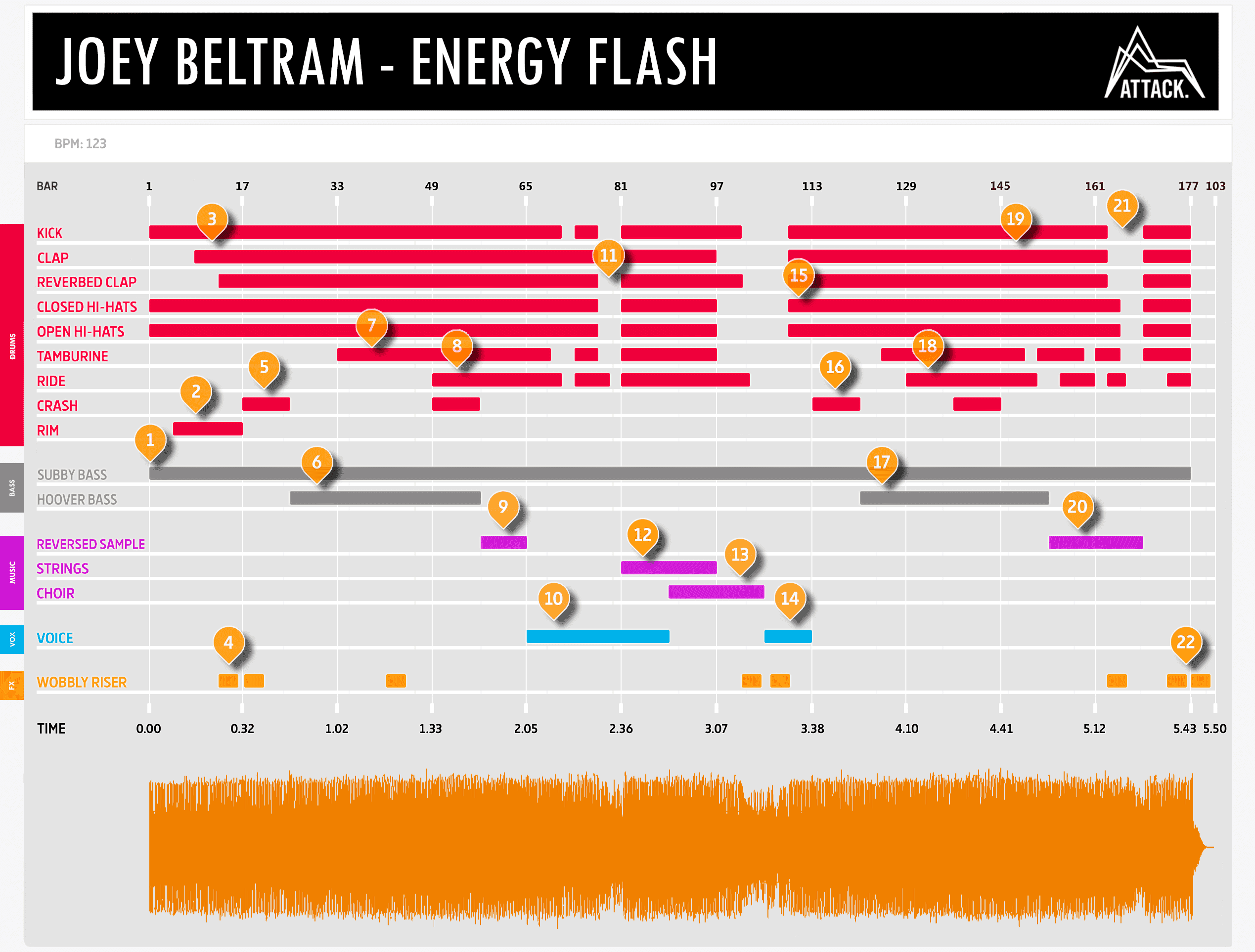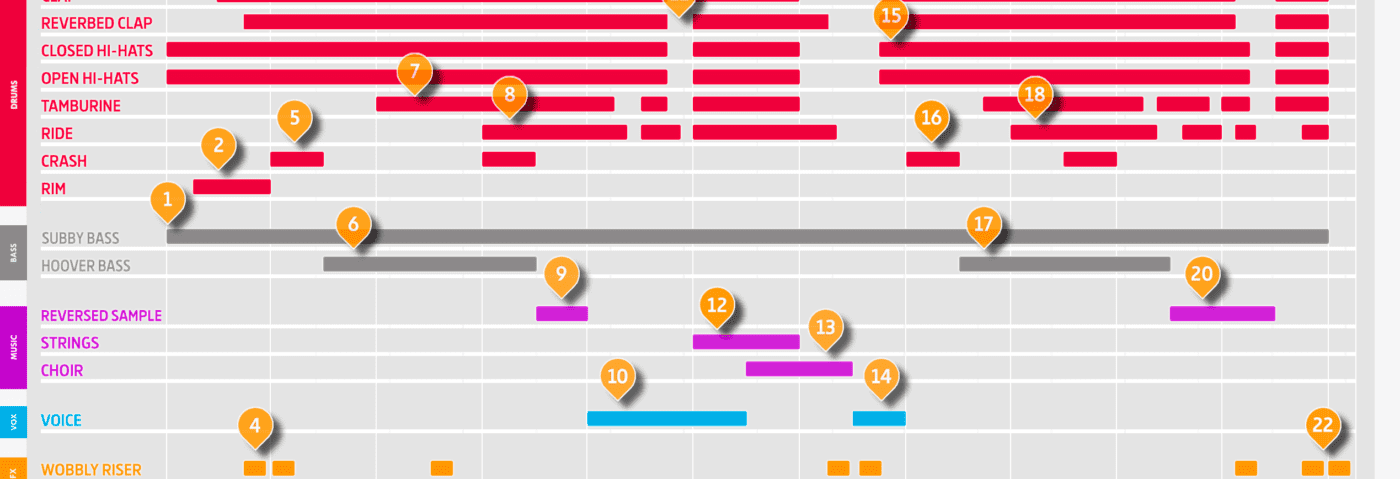In this Deconstructed, we take a look at Joey Beltram’s smouldering techno classic, ‘Energy Flash’.
In 1989, a 19-year-old Joey Beltram created a track that would help usher in a new, darker strain of techno and go on to influence a countless number of producers. Released on Belgian imprint R&S Records in 1990, ‘Energy Flash’ was Beltram’s breakthrough production and a pushback against the feel-good melodies that had been creeping into dance music thanks to the then-popular genres of Italo piano house and New York garage. Dark, moody, and heavy, ‘Energy Flash’ was an instant hit, and was even licensed for US distribution by Derrick May’s label, Transmat Records.
Beltram would go on to create a few more hits, including his remix of Human Resource’s ‘Dominator’ and original cut ‘Mentasm’, which he co-produced with fellow New Yorker Mundo Muzique under the name Phase Two. Both of these tracks featured ‘hoover’ sounds, tearing, warbling synth leads that would go on to become sample fodder for years to come. But it is ‘Energy Flash’ that remains Beltram’s definitive moment.
Thirty years on, the track still sounds fresh and modern. The triple punch combination of solid production, simple but devastating programming, and an unusual three-part arrangement make it a timeless classic, one that can still melt faces and destroy dance floors even today.
Let’s break the track down and see what’s happening, tease out why it remains so effective, and see what we can learn from it.
The Track
The Arrangement

What’s Happening?
1
‘Energy Flash’ begins in full flight, with the drums and bass already off the ground. The beat is largely handled by a Roland TR-909, with a steady four-to-the-floor kick drum driving the rhythm. A 16th note pattern of closed hats interplays with the open hats, which have been programmed to accent the offbeat and give a sense of lift to the rhythm. This is in contrast to the bassline, which is heavy and relentless, never stopping throughout the song. The bass is also extremely subby, something of a rarity for the time. It gives the track a tremendous sense of weight and foreboding. The bassline itself sticks close to a low A flat and serves as the root note of the song, which is in A flat major.
2
Five bars in, Beltram adds a rim shot pattern from a Roland TR-707. It’s extremely dry, as are most of the percussion sounds in ‘Energy Flash’. The 707 was a popular drum machine with the early Chicago house producers, of whom Beltram was a professed fan. It’s also brighter than the 909 rim, and stands out against the background of the thunderous bassline, which may be why he went with the 707 version. Surprisingly, the rim shot will stop at bar 18, never to return.
3
‘Energy Flash’ is a fairly simple song, but its power lies in the way it slowly ramps up the tension. Adding percussion sounds one by one is a tried and true way to do this, and Beltram’s track is a masterclass in this. True to form, at bar 9 the next percussive element takes the stage, this time a 909 clap sounding on the 2 and 4 positions, with extra fill claps inserted at the end of each four-bar section. Notice that there’s no snare in this track, only comparatively lighter hand claps.
4
The next percussion sound enters here, and it’s surprisingly another hand clap, this one pitched slightly higher than the first. It’s panned hard to the right and is treated with a bright and long reverb with a delayed onset. This creates a ‘splash’ effect and lets us hear the transient of the clap. The way the mix confuses our sense of space is particularly striking, with the large, reflective reverb coexisting with the other ‘dead’, dry percussion sounds. A moody, wobbly filter riser, heavy with resonance, also makes its entrance here. The riser is drenched in tight, metallic reverb, further contributing to the spatial disorientation.
5
The song continues to build the tension, next by adding a steady, almost martial, TR-909 crash pattern. Accompanied by more filter risers, it efficiently and successfully drives us towards the focus of the track, coming next.
6
At bar 25, we first hear the famous ‘Energy Flash’ bassline. A one-note A flat pulsing sequence, it hovers above the sub-bass like a bouncing ball bearing. The monotony of the sequence is obliterated by the sound design, with the filter resonance increasing and decreasing in an almost robotic way. This is not an acid squelch fest. It’s much too controlled for that. There’s very little here that hints at the human behind the scenes at all. The use of reverb and delay on the bass is masterful. The reverb is tight and metallic, suggesting an enclosed room, while the delay, panned to the right, simultaneously suggests something more expansive. In the right environment, like a cavernous warehouse, the effect is bewildering.
7
Although much of the extraneous percussion dropped out at bar 25 to place focus on the top line bassline, at bar 33 percussion is again introduced to increase tension. This time it’s a 909 tambourine pattern, programmed in insistent 16th notes that add propulsion to the bassline, still pulsing along.
8
At bar 41 the filter risers enter again, followed by 909 crashes at bar 49, heralding the coming change in the structure of the song. Bar 49 also introduces a line of 909 rides, panned left and working in syncopation with the hats and tambourine. It should be noted that the bassline at this point is not increasing in tension, as one might expect, but flicking back and forth through states of varying degrees of intensity.
9
‘Energy Flash’ is unusual in that it has a three-part structure, much like a movie. Here the second part of the track, the middle section, begins. The top line bassline drops out and is replaced by a sample of a string section, reversed and looped into a descending phrase. This was sampled from Orbital’s ‘Chime,’ a big hit for the UK duo the same year ‘Energy Flash’ was recorded. Here it’s run a little slower to match the 123 BPM tempo. After the ‘heat’ of act I of the song, the descending notes give us a chance to cool down, much like a breakdown in a modern track. Lots of delay makes the string sample seem full and expansive.
10
At this point, the strings stop and are replaced by another repeated sample, this one of a man whispering “ecstasy.” The voice is unnaturally slow, likely achieved by triggering the sample below the root key. This is followed by a second trigger of the voice, slightly slower than the first, and this two-note phrase is repeated at regular intervals throughout the rest of the song. The sample likely came from ‘Rock To The Beat’ by 101, a Belgian cover of Reese & Santonio’s track of the same name.
11
‘Energy Flash’ is remarkably steady, with few fills to announce changes in theme or mood. There are two small breakdowns in the middle section though, the first at bar 71 and the second at 77, with the kick drum dropping out to relieve the pressure. Some of the other percussion sounds get a breather as well, although not for long.
12
At bar 81 the steady kick drum resumes its duties, along with most of the other percussion minus the rim shot. The voice continues to intone “ecstasy” while a new melody enters, a two-note synth string line, playing F and G sharp, only a semitone apart. Much like the piano line in the ‘Halloween Theme’, the proximity of the notes and the dissonance in their overlap, creates a feeling of dread.
13
Next, a second instrument, a choral sample, appears, directly mirroring the string line and playing on top of it. This doubles down on the dissonance and unease of the string line. The gothic feel of the choral line contributes to the horror soundtrack atmosphere.
14
If ‘Energy Flash’ can be said to have a breakdown, this is it. Only eight bars long, all the drums drop out except for the rides, which also drop out by bar 102. The moody riser returns, and as the choral sample ends, the ecstasy sample returns. Finally, the riser begins again, leading us to the next and final part of the song.
15
At bar 109 part three of the song starts. It mirrors part one for the most part, although there are some significant changes. Before things start to ramp up again, though, we’re given a four-bar drum beat and repeat of the two-note ecstasy line. It’s fairly unusual to have four bars of anything in a dance song, with most songs relying on eight- or 16-bar measures. It’s another example of how ‘Energy Flash’ confounds expectations and creates a unique, often confusing mood.
16
Here we start to build back up properly, with the steady 909 crashes playing the same steady pattern as in 5. Tension is palpable as the listener by now knows what’s coming, the regularity of the crashes by now familiar to the listener through repetition.
17
And the payoff. The top line bassline, still pounding out that single A flat note, returns. While the timbre of the pulses are the same, the pattern of how the filter changes is less methodical and more erratic, jumping between settings seemingly randomly.
18
Again, as in part one, percussive elements are reintroduced one by one, with tambourines starting at bar 125, the rides at bar 129, and crashes again at 137. Where most songs would be winding down at this point, removing percussion to give the DJ a chance to mix into the next record, ‘Energy Flash’ still has business to take care of.
19
At bar 145, the 909 clap pattern abandons its post on the 2 and 4 and becomes disjointed and more varied, reflecting the breakdown in regularity begun by the bassline pulse.
20
We’re nearing the end of the song, and to announce this the string motif is brought back at bar 153 at the same time as the bass pulse ends. The claps become steady again, which, along with the strings, prepares us for the song to end and/or for the next song to be mixed in. The 909 rides reappear at bar 155, stopping again after an unusual six bars and then starting again at bar 163.
21
Just before the end, there’s something of a mini breakdown of four bars, with first the kick and then the hats dropping out, and lastly the rides giving up for good at bar 168. The strings continue until the end of the breakdown at bar 169.
22
And so we come to the outro of the song. Most of the percussion elements—kick, claps, hats, and tambourine—are present, with even the 909 rides making one last appearance at bar 173. The woozy riser returns two more times, and the song ends with echoes of the final riser repeating until fade out. It should be noted that the outro to ‘Energy Flash’ is only eight bars long, which is not very much for a DJ to work with. It’s clear that—despite his love for tracky Chicago house—Beltram was going for something a little unorthodox here, and many of his programming choices, including the length of the outro, support this.
